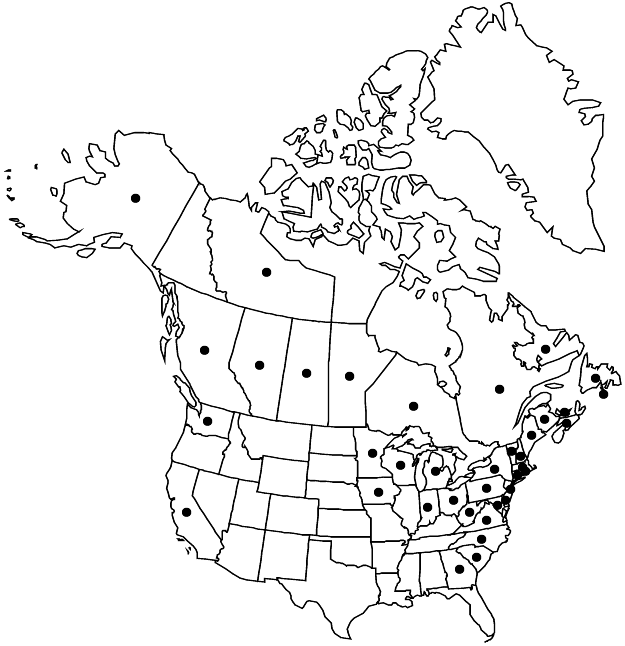Sarracenia purpurea
Sp. Pl. 1: 510. 1753, name conserved,.
Plants forming dense clumps; rhizomes 0.3–1.5 cm diam. Pitchers persistent, appearing with or after flowers and continuously all summer, decumbent or sprawling to ascending, nearly green with various degrees of red or purple veins, or suffused reddish or purplish to nearly uniformly purplish red, without white areolae, urceolate (gently S-curved like a hunter’s horn), 5–25 (–45) cm (bulging distal of middle, 3–6 cm at widest point), firm, sometimes shiny or waxy, external surface glabrous or glabrate to densely pubescent, wings 1–3 (–4) cm diam.; orifice round to oval, (gaping, with rainwater held in pitcher), 1.4–3.6 cm wide, rim green to purplish red, (thick, flaring), loosely revolute, scarcely or not indented distal to wing, (0.7–3.1 mm wide at thickest point); hood erect or with lobes arched together over orifice, same colors and veined as pitcher, reniform, undulate or entire, 2–5 × 3–7 cm, wider than long, basal lobes cordate, attached to sides of rim of orifice with no neck, distal portion somewhat abaxially recurved and notched apically, apex not apiculate, adaxial surface with decurved setae 0.6–1.8 (–3) mm. Phyllodia absent. Scapes 22–79 cm, much longer than pitchers; bracts 0.5–0.8 cm. Flowers moderately fragrant to mixed fragrant and ill-scented; sepals purplish red, 2.2–4.2 × 1.5–3.5 cm; petals red to maroon, distal portion elliptic to obovate, 3.3–5.3 × 1.5–3 cm, margins entire; style disc green, 4–5 cm diam., (style arms 1.7–3.8 cm). Capsules 1–2 cm diam. Seeds 1.7–2 mm. 2n = 26.
Distribution

Alta., B.C., Man., N.B., N.S., N.W.T., Ont., P.E.I., Que., Sask., Alaska, Calif., Conn., Del., Ga., Ind., Iowa, Maine, Mass., Md., Mich., Minn., N.C., N.H., N.J., N.Y., Ohio, Pa., R.I., S.C., Va., Vt., W.Va., Wash., Wis., in Europe, Asia
Discussion
Subspecies 2 (2 in the flora).
Sarracenia purpurea is probably the most recognized of the pitcher plants. It has rapidly and effectively populated peat bogs in the northern regions during the 10,000–12,000 years since glaciation. It is the only pitcher plant that grows naturally north of southeastern Virginia; in North America, it has become naturalized at least in northern California and the Pacific Northwest. While it may be the stereotypical pitcher plant to the general public, it is atypical of Sarracenia species in that it, along with S. rosea, holds rainwater.
Within Sarracenia purpurea, there is much overlap of character states among the infraspecific taxa, and there are always exceptions and problematic specimens, especially where they may hybridize with other species in the Carolinas. See D. E. Schnell (1979, 1981) for further discussion of variants. C. R. Bell (1949), S. McDaniel (1971), and A. M. Ellison et al. (2004) did not accept the subspecies designations presented by E. T. Wherry (1933, 1972); we believe that there are sufficient morphological distinctions that are substantiated by observations made in uniform garden culture (Case, pers. obs.; Schnell 1979) to recognize subspecies.
Selected References
None.
Key
| 1 | Pitchers glabrous or glabrate externally, lengths 3.5+ times diam.; setae on adaxial surface of hood 0.6-1.2(-2.2) mm; se Virginia and mountains of Georgia, North Carolina, and South Carolina, northward. | Sarracenia purpurea subsp. purpurea |
| 1 | Pitchers usually distinctly pubescent externally, lengths to 3.5 times diam.; setae on adaxial surface of hood 1.1-1.8(-3) mm; Atlantic coastal plain and piedmont of North Carolina southward through South Carolina and e Georgia. | Sarracenia purpurea subsp. venosa |
"winged" is not a number."variable" is not a number.No values specified.